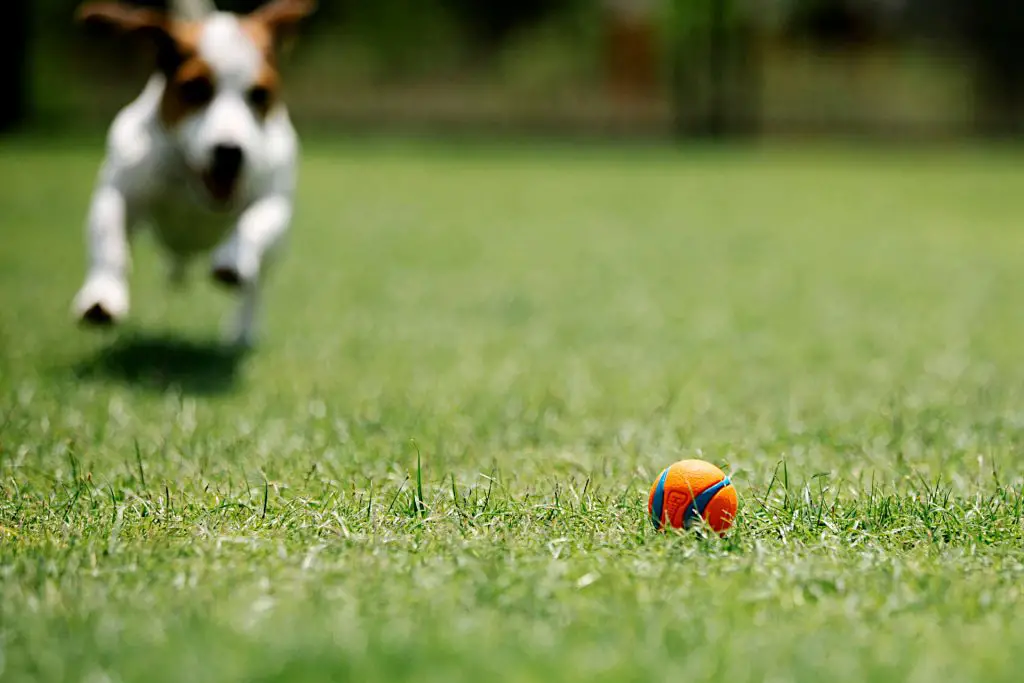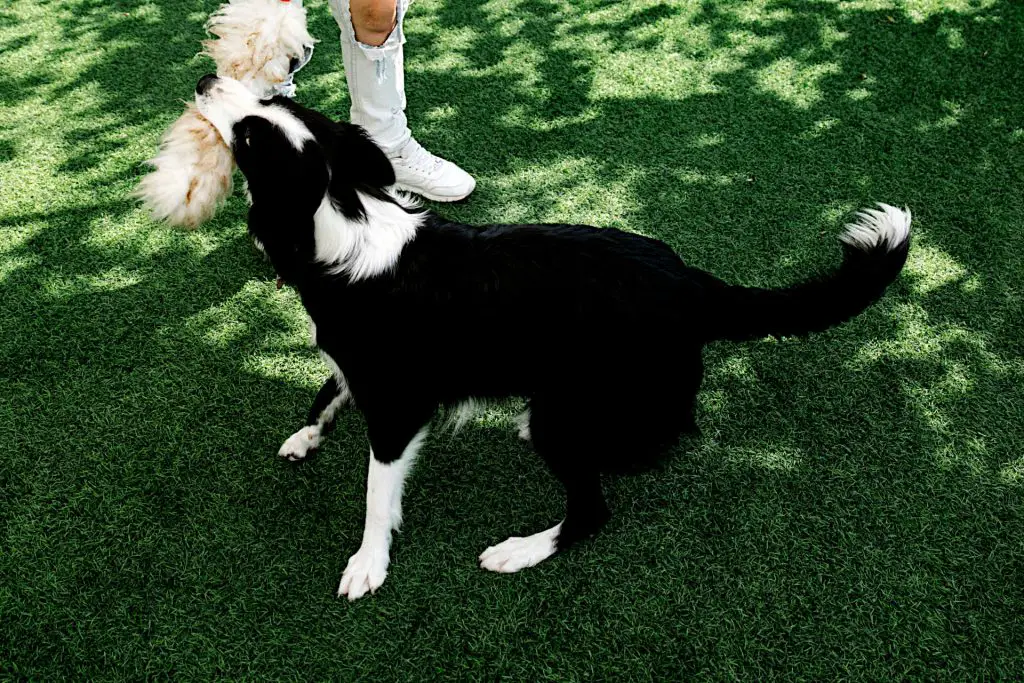Artificial Turf for Dogs Pros and Cons – Is Artificial Turf the Best Option for Your Dog?
Artificial turf has become an increasingly popular alternative to real grass with thousands of installations happening across the country in all types of climates. One question though that needs to be considered in choosing synthetic turf over natural grass is the implications for pets and specifically dogs.
When it comes to dogs and their health, there are a few things to consider when deciding if artificial turf is the best surface for them. While some people think that an artificial turf lawn is a good option for dogs because it’s easy to clean and doesn’t have any organic matter that could attract pests, there are also some disadvantages to consider.
Artificial Turf can be an excellent surface for dogs. Not only is it a very safe product, constructed from materials that many household products are made from, it also has many useful and functional benefits, such as looks, durability, and is chemical free. However, there are some disadvantages relating to climate and cost that need to be taken into account before deciding on installing it.
The Advantages of Having Artificial Grass when Owning a Dog

There are a considerable number of advantages to having artificial grass if you are a dog owner not only for you but also for the dog itself. Not only will it make both your lives easier by saving time and money on cleaning up after your dog, but it will also help keep your dog healthy as well. Here are just a few reasons why you should consider installing artificial turf:
With Artificial Turf There Is No Mud
Dogs love to run and play outdoors, but when the ground is wet, muddy, and covered in debris, it can be difficult for them to move around without them becoming caked in mud and dirt.
This is where artificial turf comes in handy because, as opposed to natural grass there is no mud or dirt that your dog can bring back into the house. It provides a clean and safe surface for dogs to run and play on, regardless of the weather conditions.
Your Lawn Remains Unsullied
One of the problems with natural grass is the damage that can be inflicted by your dog on its surface. From digging holes, the chewing off blades of grass to creating worn and bare paths across the ground, there are many ways that dogs can destroy the natural look of a yard. This is something that artificial turf does not suffer from at all.
Synthetic Lawns Are Tough and Durable
Indeed, with synthetic grass, perhaps the most convincing reasons to install it are its toughness and durability. Synthetic lawns can stand up to pet use, which is great news for animal lovers. Pets will be happy to have a soft surface to run around and play on, and you’ll be happy knowing your lawn is safe from their claws and paws. This means that, unlike real turf, your installation will remain as a beautiful green lawn irrespective of use.
Synthetic Grass Doesn’t Harbor Ticks and Fleas
Dogs are often susceptible to ticks and fleas, which is important for the health of your dog as these insects can transmit diseases that can lead to health problems. With artificial turf, because, unlike natural grass, it is constructed from made of synthetic materials, you don’t have to worry about your dog picking up ticks or fleas and is a good option for keeping your dog free from them.
They Are Free from Fertilizers and Pesticides that Can Affect Dogs

Every year, Americans spend more than $1 billion on pesticides and fertilizers for their lawns and gardens. These products can be harmful to both pets and people. Artificial turf is a great alternative to traditional natural grass lawns as it doesn’t require these lawn care products. As such, artificial turf is free from fertilizers and pesticides that can affect dogs.
The Disadvantages of Artificial Turf For Dogs
As a dog owner whilst there are clearly many advantages to artificial lawns there are some considerable disadvantages to having artificial turf that needs to be understood before looking to install an artificial lawn.
The Upfront Cost of Installing an Artificial Lawn
When it comes to artificial turf for dogs, one of the main cons is the extra upfront costs of installing an artificial lawn. Depending on the size of your yard and the type of turf you choose, the price can range from a few hundred to a few thousand dollars. If you already have a natural lawn, you’ll also need to factor in the cost of removing your existing grass and replacing it with artificial turf.
What Are the Costs of Turf and Its Installation for Dogs?
Artificial dog turf is becoming a more popular option for pet owners. There are several benefits to using artificial turf over traditional grass, including the fact that it does not require regular maintenance and that it can be used indoors or outdoors.
The cost of artificial dog turf varies depending on the size of the area that needs to be covered, but typically ranges from $5 to $10 per square foot. Installation costs may also vary depending on the complexity of the installation but typically range from $50 to $100 per hour. Can artificial dog turf be installed using a do-it-yourself approach? Most times, it can. The installation process is simple and requires only a few tools.
Cleaning Artificial Turf

It is a misapprehension, however, to assume that since it isn’t live, it thus needs little or no upkeep. In truth, artificial grass has particular demands when it comes to care and maintenance all of which aid in ensuring that it always looks its best and prevents it from deteriorating.
The frequency and extent of cleaning will depend on the amount of foot traffic in your home will be determined by how often it is used. This could be daily, weekly, and/or monthly. Read here for more information on keeping your artificial lawn clean.
Neutralizing Bacteria and Smells
The additional problem is dealing with bacteria and odors from pet waste. There are though, many ways to clean and neutralize bacteria and smells. Some methods are more effective than others. The most important thing is to be consistent with the cleaning and neutralizing routine.
Besides the multitude of commercial products available, there are several homemade and natural solutions that can do the job. One of the most popular methods for cleaning and neutralizing bacteria is to use bleach. Bleach can be used to clean surfaces or to disinfect water. It is also effective at removing bad smells. However, bleach can be harmful if it is not used correctly.
Another method for cleaning and neutralizing bacteria is to use vinegar. Vinegar can be used to clean surfaces or to disinfect water. It is also effective at removing bad smells. Vinegar is a natural product and is less harmful than bleach if bleach is not used correctly.
Artificial Turf and The Effect of Heat on Dogs
As the weather continues to heat up, many people are looking for ways to beat the effects of heat and climate on their gardens. Unfortunately, for dogs, one of those ways may be dangerous. Synthetic grass can get extremely hot in direct sunlight and can cause dogs to suffer from burns or worse.
It is not just the surface temperature, the heat from the grass can increase the air temperature directly above and around the areas of artificial lawn. Dogs that play on artificial turf may not be able to tell you what is wrong. Many of the symptoms can be similar to those of heatstroke or hyperthermia.
You can cool artificial turf by watering it, although the effect is limited, so it is advisable to keep dogs off of it in the worst heat of the day.
Synthetic Turf Designed Specifically For Dogs
There are a number of manufacturers who have spent time looking to mitigate the negative factors preventing owners from choosing artificial grass.
These can include heat set nylon monofilament, which mitigates heat build-up, a unique turf backing that employs mechanisms to enable the urine to flow through it rapidly and to assist in creating and maintaining a cleaner environment.
The synthetic fibers of these dog-friendly turf products are made from safe, non-toxic, quality materials that are coated with antimicrobial technology integrated directly into the blades; making them good for almost any setting.
Summary: The Pros and Cons of Artificial Turf for Dogs
There are pros and cons to using artificial turf for dogs. Some people feel that it is a great option because it is easy to clean and maintain. It also provides a soft surface for dogs to play on. However, some people believe that artificial turf can be harmful to dogs because it can cause them to overheat and can also be a breeding ground for bacteria if not kept clean.
